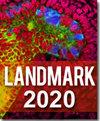中国4526例手术切除眼肿瘤组织病理学检查的年龄分布。
IF 3.1
4区 生物学
Q2 Immunology and Microbiology
引用次数: 2
摘要
背景:越来越多的证据表明,不同年龄组和人群患眼肿瘤的风险不同。本研究的目的是评估中国眼部肿瘤的年龄分布。方法回顾性分析2001年至2017年收集的4492例(4526只眼)手术切除和组织学证实的各类眼肿瘤的年龄分布。结果4526例标本中,良性肿瘤3156眼(69.7%),恶性肿瘤1370眼(30.3%)。眼部肿瘤的年龄特异性发病率呈双峰分布,0 ~ 9岁为高峰(19.7%),50 ~ 59岁为高峰(14.7%)。20岁以下的眼睑恶性肿瘤非常罕见,但到70岁时,恶性肿瘤占所有眼睑肿瘤的78%。0-9岁儿童患恶性眼肿瘤的可能性是10-19岁儿童的6.5倍(95% CI, 4.1-10.4)。眼肿瘤在前10大类良性(p < 0.001)和恶性(p = 0.001)中均存在年龄相关性变化。结论年龄是决定眼肿瘤类型的主要因素,经组织病理学分析证实。本文章由计算机程序翻译,如有差异,请以英文原文为准。
Age Distribution of 4526 Surgically Excised Specimens of Eye Tumors by Histopathological Examination in China.
BACKGROUND
Cumulative evidence suggests that the risk of eye tumors varies among different age groups and populations. The purpose of the present study was to assess the age distribution of eye tumors in China.
METHODS
In this retrospective study, the age distribution of various types of eye tumors was analyzed on surgically excised and histologically confirmed specimens obtained from 4492 patients (4526 eyes), collected between 2001 and 2017.
RESULTS
Of the 4526 specimens, 3156 eyes (69.7%) had benign eye tumors, while 1370 eyes (30.3%) had malignant tumors. The age-specific incidence of eye tumors was characterized by a bimodal distribution, one peak occurred at age 0-9 years (19.7%) and the other at 50-59 years (14.7%) of age. Malignant eyelid tumors were very rare under the age of 20 years, but increased to 78% of all eyelid tumors by the age of 70 years. Children aged 0-9 years old were 6.5 times as likely to have a malignant eye tumor (95% CI, 4.1-10.4) as those aged 10-19 years. The age-related variation of eye tumors was also observed in the top ten categories of both benign (p < 0.001) and malignant types (p = 0.001).
CONCLUSIONS
These results showed that age is a major factor determining the type of eye tumor, confirmed by histopathological analysis.
求助全文
通过发布文献求助,成功后即可免费获取论文全文。
去求助
来源期刊

Frontiers in Bioscience-Landmark
生物-生化与分子生物学
CiteScore
3.40
自引率
3.20%
发文量
301
审稿时长
3 months
期刊介绍:
FBL is an international peer-reviewed open access journal of biological and medical science. FBL publishes state of the art advances in any discipline in the area of biology and medicine, including biochemistry and molecular biology, parasitology, virology, immunology, epidemiology, microbiology, entomology, botany, agronomy, as well as basic medicine, preventive medicine, bioinformatics and other related topics.
 求助内容:
求助内容: 应助结果提醒方式:
应助结果提醒方式:


